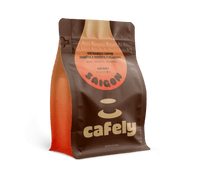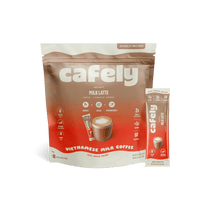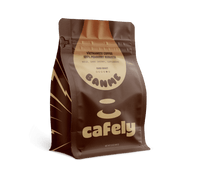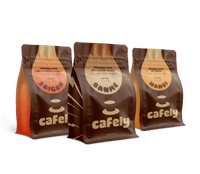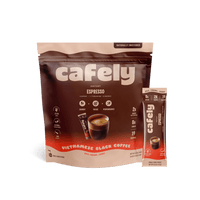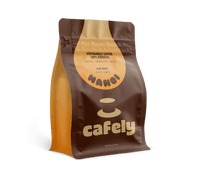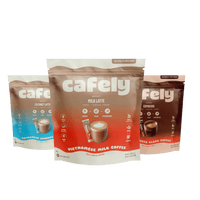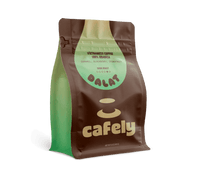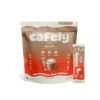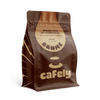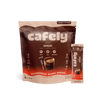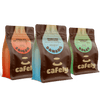You’re searching through your pantry and find a dusty box of coffee pods hiding behind a bag of rice. The date passed months ago, maybe even a year, but do coffee pods expire, and is it still safe to use that box?
The answer depends on a few key factors, including what type of pod you have, how it’s packaged, and how long it’s been sitting around.
In this guide, we’ll explain how long coffee pods last, what the printed dates mean, how pod design helps preserve freshness, and how to tell when it’s time to let a pod go.
Do Coffee Pods Expire? Technically... No, But They Can Go "Off"
Coffee pods don’t “expire” the way perishable foods do, but they do go stale over time.
Most pods come with a "best by" date, not a hard expiration date. This means the product is expected to taste its best before that date, but it likely remains safe to consume after.
Coffee pods are designed with longevity in mind. Most manufacturers flush the pod with nitrogen to remove oxygen and then hermetically seal it in plastic or aluminum. This prevents oxidation, the main culprit behind stale coffee, allowing it to last significantly longer than ground coffee stored in an open bag.
So, yes, you can technically use a pod past its date. But for the best-tasting brew, aim to stay within a few months of the "best by" date, especially for more delicate blends or flavored options.
What's The Difference Between Best By Date and Expiration Date?
The “best by” date is based on internal testing by manufacturers, who evaluate when the coffee's aroma, taste, and strength begin to noticeably degrade. While safety isn’t usually the concern, flavor quality drops over time. You won’t get sick from an old pod, but your morning cup might taste flat or sour.
An “expiration date,” on the other hand, marks when a product is no longer guaranteed to be safe to consume. After this point, spoilage or health risks become a concern — making it important to know how to keep your coffee fresher for longer.
Understanding Coffee Pod Shelf Life by Type

Coffee pod longevity depends on the type of capsule, the material it’s made from, and what's inside.
Here's how the most common varieties compare:
1. K-Cups (Plastic Pods)
K-Cups for a Keurig coffee maker are made of plastic with a foil lid and an internal paper filter. They're sealed to preserve freshness and typically last 8-12 months, but the filter can absorb moisture if exposed to humidity, increasing the chance of mold over time.
2. Nespresso Original Line Capsules (Aluminum)
When brewing with Nespresso, pods are built for long-term freshness, with a shelf life of 18 to 24 months. Their fully airtight aluminum construction offers excellent protection from oxygen, moisture, and light, which helps preserve the coffee’s flavor and aroma better than plastic.
3. Nespresso Vertuo Capsules
Vertuo capsules offer the same aluminum protection and vacuum sealing as the OriginalLine. With a typical shelf life of up to 24 months, they also feature barcode-based precision brewing, which adds a layer of consistency to the taste, even months after purchase.
4. Compostable or Biodegradable Pods
These eco-friendly options tend to have a shorter shelf life of 6 to 9 months. Made with plant-based or paper materials, they’re more permeable to air and moisture. For best results, it’s wise to use them soon after purchase before flavors begin to degrade.
5. Flavored Coffee Pods
Due to the use of natural oils and added flavorings, these usually stay at peak taste for around 6 to 9 months. After the “best by” date, flavored coffee may taste artificial or stale, even if the coffee itself is technically still safe to brew.
6. Roast Level Considerations
If you consider dark roasts, choose the best options. Dark roasts often have slightly more shelf stability because of their lower moisture content, but their bold oils can go stale quickly once exposed. Lighter roasts retain subtle, delicate flavors longer, but are also more sensitive to time and air exposure.
How to Read the “Best By” Date
Most coffee pods include a date printed somewhere on the box or pod foil lid. It’s usually labeled as:
- “Best By”
- “Use Before”
- “Freshest Before
If you can’t find the date on the pod itself, check the original outer packaging. For bulk packs, only the box may be labeled.
Keep in mind:
- This is not a hard safety deadline.
- Pods used shortly after this date are generally fine.
- For best results, consume within 3 to 6 months of the date.
Signs Your Coffee Pods Are No Longer Good

While coffee pods are designed for long shelf life, they are not immune to spoilage or quality loss. Even if the printed date looks acceptable, there are clear warning signs that a pod should be tossed instead of brewed.
1. Damaged or Compromised Packaging
If the pod's foil lid looks puffed up, dented, or torn, it likely means the seal is broken. When air gets in, the coffee inside becomes vulnerable to oxidation, moisture, and even mold growth. If you find a pod like this, just throw it away, regardless of the date on the box.
2. Soft or Squishy Texture
Pressing on a coffee pod should reveal a firm, sealed shape. If the pod feels soft, collapsed, or unusually pliable, that’s often a sign that moisture has entered the container. Moisture accelerates spoilage and increases the risk of bacterial contamination, especially in pods with paper filters.
3. Visible Mold or Clumping Inside
While uncommon in properly stored pods, mold can appear if the seal is broken or the pod has been exposed to high humidity. If you open a pod and notice fuzzy growth, discolored coffee grounds, or clumps sticking together, do not use it. Mold contamination poses real health risks and should never be ignored — be sure to choose trusted mold-free coffee options.
4. Unpleasant or Muted Aroma
Fresh coffee has a strong, roasted scent that’s easy to recognize. When a pod smells musty, sour, or bland, it’s usually a sign that the natural oils in the coffee have broken down. While this may not make the pod dangerous, it often means the flavor will be noticeably dull or unbalanced.
5. Off Taste & Loss of Crema
Old pods tend to brew flat or overly bitter coffee, lacking the richness and smooth balance you’d expect. Espresso-style pods may also produce less crema, which indicates a loss of freshness. If the taste is unpleasant, there’s no reason to keep drinking it, especially when the experience no longer matches the original roast.
6. Digestive Discomfort After Drinking
In rare cases, stale or poorly stored pods may lead to mild stomach upset. This can happen when oxidation byproducts or microbial contamination develop inside the pod over time. If you notice a stomach ache after drinking the coffee, and the pod seems old or damaged, it’s best to stop using that batch.
When to Discard Coffee Pods
If the pod is bloated, leaking, moldy, flavorless, or over a year past its date, it’s time to let it go. Trust your senses. If it looks, smells, or tastes wrong, it probably is.
Proper Storage & Disposal of Coffee Pods
Keep coffee pods in a cool, dry location, ideally a pantry or cabinet, away from sunlight and appliances that give off heat.
Avoid storing coffee pods near your coffee maker, oven, or on a windowsill. Excess warmth and humidity can weaken seals and degrade freshness.
You can also use airtight containers for bulk coffee pod storage to protect them from ambient moisture. While freezing is not recommended (due to condensation risks), room temperature in a sealed container works best for maintaining quality over time.
Environmentally Friendly Disposal Options
One of the biggest criticisms of coffee pods is their environmental impact. But, there are responsible ways to dispose of them — or get creative and repurpose them.
Recycling is possible for many brands:
- Nespresso aluminum pods are widely recyclable, and the company runs its own return program.
- K-Cups made of #5 plastic can often be recycled if you remove the lid and empty the grounds.
- Compostable pods (like those made of plant starch or paper) should be disposed of in a commercial compost facility, not backyard compost, unless labeled as home-compostable.
Before recycling, separate the components:
- Peel off the foil lid.
- Dump out the used coffee grounds (these are compostable and great for gardens).
- Rinse the pod shell, if required by your local recycling center.
Used coffee grounds can be repurposed in several ways:
- Add to garden soil as a nitrogen-rich compost.
- Use as a natural deodorizer in the fridge or trash bin.
- Make homemade body scrubs by mixing with coconut oil and sugar.
Creative reuse of empty pods is also an option. Some people turn them into seed starters, holiday lights, or mini paint pots for kids’ crafts.
FAQs About Coffee Pod Expiration
You still don’t know what to do with your old pods. Here are quick answers to clear your questions.
1. Is It OK to Use Expired K-Cups?

Yes, expired K-Cups are usually safe if the seal is intact and there’s no visible damage. However, the flavor and aroma may fade over time. Keurig notes that pods past their "best by" date might lose quality but can still be used if stored properly.
2. What Is the Shelf Life of Keurig Coffee Pods?
Keurig pods typically last 8 to 12 months from the manufacturing date. Dark roasts and flavored options may have slightly shorter shelf lives. Always store them in a cool, dry place, and check the printed date on the bottom or side of the packaging.
3. Is It OK to Use Expired Pods?
Expired pods are generally safe if the packaging is sealed and undamaged. Quality may drop after the "best by" date, so inspect for stale smells, broken seals, or off flavors. Use within 3 to 6 months of expiry for the best taste.
4. How Long Do Coffee Pod Machines Last?
Most pod coffee machines last 3 to 5 years with regular use and maintenance. Cleaning and descaling every 1 to 3 months helps extend the lifespan. A drop in brew quality, unusual noises, or slow dispensing usually signals it's time for a replacement.
5. What to Do With Coffee Pods After Use?
Separate the pod components and recycle where possible. Many brands offer mail-back programs, while others require peeling and rinsing before recycling. Compostable pods should go to commercial compost sites. Grounds can be composted or reused in gardens as fertilizer.
6. Can You Drink Out of Date Coffee Pods?
Yes, you can drink them if the seal is intact and the pod looks and smells normal. Taste and aroma may decline with age, but they’re not unsafe. Discard if the pod is bloated, punctured, moldy, or if the contents smell stale or sour.
7. How Long Should You Keep Coffee Pods?
For best quality, use coffee pods within 6 to 12 months of purchase. Store them in a cool, dry spot away from moisture and heat. Rotate your stock regularly if buying in bulk to ensure older pods get used first.
8. Do They Really Recycle Coffee Pods?
Some brands do, like Nespresso’s aluminum pod program or Keurig’s recyclable plastic cups, but success depends on local recycling rules. Many pods still end up in landfills due to mixed materials. Always check disposal guidelines and prep pods by separating materials.
9. Is It Safe to Reuse Coffee Pods?
Reusing single-use pods is not recommended by manufacturers and may damage your machine. If you prefer refills, use dedicated reusable pods designed for your system. Clean thoroughly between uses to avoid bacteria buildup and ensure proper water flow.
10. What Can I Do With Old Coffee Pods?
Old pods can be repurposed as garden planters, craft organizers, or scent diffusers using dried grounds. Coffee grounds enrich compost or can be used to deodorize spaces. You can also donate unused, sealed pods to food banks or local shelters.
